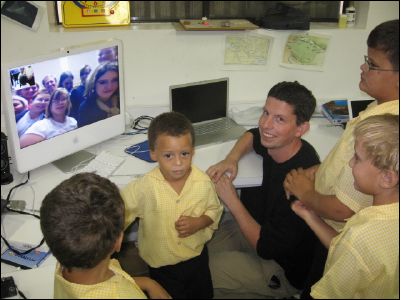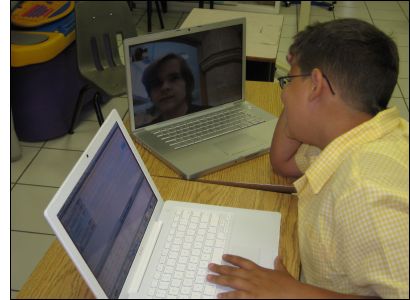
The past week has been pretty tiring, but incredibly worthwhile and satisfying. It began with very clear objectives to build a link between the little learning community on Little Cayman and Stepping Stones School in the UK. Both schools, although small, are fantastic places for pupils to learn. The school on Little Cayman has four pupils aged between 4 and 10, and although the age spread is somewhat different, Stepping Stones School has a similar number of pupils - seven!
Small learning communities work really well, but in order to thrive, the pupils need to experience a much greater social network or youngsters - something that both learning communities have in common. The obvious answer is to bring the two together using video technology, provided wholly through iChat AV on the Apple Macintosh. The photograph above shows the quality of the video as we broadcast live across the Atlantic.
Video conferencing is not a new technology, in fact it's been around for several years - so people might ask, what's the big deal? Well, quite a lot, actually - and some of it isn't immediately obvious, though it is common sense.
Video conferencing technology, in the main, tends to be professional, specialised equipment which is positioned in a particular room, connected in one location. It often requires the need for a technician to set it up - line test the call - perhaps even around the routing with prior arrangement from the network's hosting company. In this project, we are using technology which puts this capability into the hands of the learners, empowering them to be in control of their connections to the outside world.
Each child has a state-of-the-art laptop computer, connected to a wireless 3Mbit Internet connection. They use Mac OS X and iChat to build a buddy list of learners in other locations. They use this to initiate video connections on an adhoc basis.

Arrowe on Little Cayman is talking to Dominic about the music he is making using GarageBand. Dominic is a bit of an expert when it comes to writing music, compared to Arrowe where this is his first time. Wouldn't it be ever so special for Dominic to pass on his wisdom and understanding to Arrowe? Well... that's exactly what happened. The age difference between the two communities of learners means that the older pupils can become role models, advocates or mentors for the younger pupils. We naturally create an environment where the younger pupils chase the role models of the older pupils and perhaps develop in thought and maturity much faster. Who knows, but it will be very exciting to watch as this project progresses over the coming months.
I've had a truly wonderful time here on the island. The pupils, both here and in Stepping Stones School have been amazing and my thanks and best wishes go to them all. I was so encouraged on my first day to hear the class teacher, Miss Veronica, suggest this technology as a strategy for joining up the schools on the sister islands, Grand Cayman and Cayman Brac - it shows an insightful understanding for this new medium which hasn't, I don't think, been fully explored beyond simply making connections.
If you are interested in learning more about this project, here are some links to other sites describing what is taking place.
Building Cayman's Future: Technology enhances Teaching and Learning
Stepping Stones School: International project goes live as pupils video conference to a school in Little Cayman
Also, please don't hesitate to contact me or book a place at the Be Very Afraid event in London, at BAFTA on 22nd October 2007. Contact Lys, lys@heppell.net for more information.